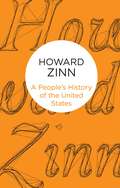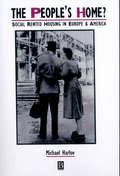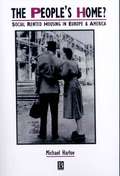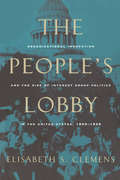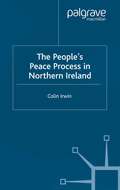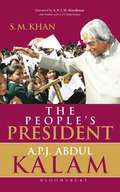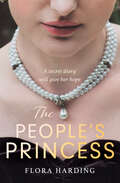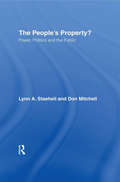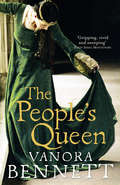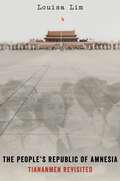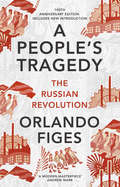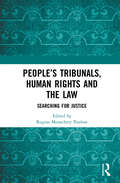- Table View
- List View
A People's History of the Russian Revolution (Left Book Club)
by Neil FaulknerThe Russian Revolution may well be the most misunderstood event in modern history. In this fast-paced introduction, Neil Faulkner debunks the myths that continue to shroud it, showing how a mass movement of millions, organised in democratic assemblies, mobilised for militant action and destroyed a regime of landlords, profiteers and warmongers.*BR**BR*Faulkner rejects caricatures of Lenin and the Bolsheviks as authoritarian conspirators, 'democratic-centralists' or the progenitors of Stalinist dictatorship; though short-lived, the Revolution of October 1917 was an explosion of democracy and creativity. Crushed by bloody counter-revolution, its socialist vision was ultimately displaced by a monstrous form of bureaucratic state-capitalism.*BR**BR*Laced with first-hand testimony, this history rescues the democratic essence of the revolution from its detractors and deniers, offering a perfect primer for the modern reader.*BR**BR*Published in partnership with the Left Book Club.
A People's History of the Russian Revolution (Left Book Club)
by Neil FaulknerThe Russian Revolution may well be the most misunderstood event in modern history. In this fast-paced introduction, Neil Faulkner debunks the myths that continue to shroud it, showing how a mass movement of millions, organised in democratic assemblies, mobilised for militant action and destroyed a regime of landlords, profiteers and warmongers.*BR**BR*Faulkner rejects caricatures of Lenin and the Bolsheviks as authoritarian conspirators, 'democratic-centralists' or the progenitors of Stalinist dictatorship; though short-lived, the Revolution of October 1917 was an explosion of democracy and creativity. Crushed by bloody counter-revolution, its socialist vision was ultimately displaced by a monstrous form of bureaucratic state-capitalism.*BR**BR*Laced with first-hand testimony, this history rescues the democratic essence of the revolution from its detractors and deniers, offering a perfect primer for the modern reader.*BR**BR*Published in partnership with the Left Book Club.
A People's History of the United States: 1492-present (P. S. Series #1)
by Howard ZinnAs seen in the award-winning feature film, Lady Bird.There is an underside to every age about which history does not often speak, because history is written from records left by the privileged.A classic since its original landmark publication in 1980, Howard Zinn's A People's History of the United States is the first scholarly work to tell America's story from the bottom up-from the point of view.Howard Zinn relays history in the words of America's women, factory workers, African Americans, Native Americans, working poor, and immigrant labourers. From Columbus to the Revolution to slavery and the Civil War – from World War II to the election of George W. Bush and the "War on Terror" – A People's History of the United States is an important and necessary contribution to a complete and balanced understanding of American history.
The People's Home?: Social Rented Housing in Europe and America (IJURR Studies in Urban and Social Change Book Series)
by Michael HarloeThe People's Home is a magisterial examination of the development of social rented housing over the last hundred years in six advanced capitalist countries - Britain, France, Germany, the Netherlands, Denmark and the USA.
The People's Home?: Social Rented Housing in Europe and America
by Michael HarloeThe People's Home is a magisterial examination of the development of social rented housing over the last hundred years in six advanced capitalist countries - Britain, France, Germany, the Netherlands, Denmark and the USA.
People's Lawyers: Crusaders for Justice in American History
by Diana Klebanon Franklin L Jonas Diana KlebanowThroughout America's history, lawyers with a crusading zeal have, through their moral stance, intellectual integrity, and sheer brilliance, made use of the law to fight social injustice. In short biographical chapters, the authors tell the stories of ten of these lawyers. Some are well known: Thurgood Marshall; William Kunstler; Louis Brandeis; Morris Dees; Clarence Darrow; and Ralph Nader. Others are not so well known, but deserve to be. All are fascinating and influential attorneys, and examination of their lives illuminates key issues in American history. An annotated bibliography; a chronology of the person's life and work; and a helpful table detailing their most prominent cases accompany each chapter.
People's Lawyers: Crusaders for Justice in American History
by Diana Klebanon Franklin L Jonas Diana KlebanowThroughout America's history, lawyers with a crusading zeal have, through their moral stance, intellectual integrity, and sheer brilliance, made use of the law to fight social injustice. In short biographical chapters, the authors tell the stories of ten of these lawyers. Some are well known: Thurgood Marshall; William Kunstler; Louis Brandeis; Morris Dees; Clarence Darrow; and Ralph Nader. Others are not so well known, but deserve to be. All are fascinating and influential attorneys, and examination of their lives illuminates key issues in American history. An annotated bibliography; a chronology of the person's life and work; and a helpful table detailing their most prominent cases accompany each chapter.
The People's Lobby: Organizational Innovation and the Rise of Interest Group Politics in the United States, 1890-1925
by Elisabeth S. ClemensIn this pathbreaking work, Elisabeth S. Clemens recovers the social origins of interest group politics in the United States. Between 1890 and 1925, a system centered on elections and party organizations was partially transformed by increasingly prominent legislative and administrative policy-making as well as the insistent participation of non-partisan organizations. Clemens sheds new light on how farmers, workers, and women invented strategies to circumvent the parties. Voters learned to monitor legislative processes, to hold their representatives accountable at the polls, and to institutionalize their ongoing participation in shaping policy. Closely analyzing the organizational politics in three states—California, Washington, and Wisconsin—she demonstrates how the political opportunity structure of federalism allowed regional innovations to exert leverage on national political institutions. An authoritative statement on the changes in American politics during the Progressive Era, this book will interest political scientists, sociologists, and American historians.
The People’s Peace Process in Northern Ireland
by C. IrwinMany important lessons have come out of the negotiations for the Belfast Agreement. This book explains how public opinion polls were used in support of the Northern Ireland peace process. Significantly, it was the politicians who decided the questions so that they could map out areas of compromise and common ground that their supporters would accept. This book explains how the work was done so that others can apply the benefits of this experience to their own peace building activities.
People's Power: Cuba's Experience With Representative Government
by Peter RomanThe study on which this book is based began in 1986 with the fifth legislative session of the Cuban municipal assemblies. The research on which the book is based was supported in part by grants from the City University of New York PSC/CUNY Research Foundation.
People's Power: Cuba's Experience With Representative Government
by Peter RomanThe study on which this book is based began in 1986 with the fifth legislative session of the Cuban municipal assemblies. The research on which the book is based was supported in part by grants from the City University of New York PSC/CUNY Research Foundation.
The People's President: Dr A P J Abdul Kalam
by S M KhanDr APJ Kalam abolished the practice of having a larger chair for the Rashtrapati on a dias when attending any function He regularly read both the Quran and the Geeta and played the veena and wrote poetry in his spare time His favourite Mahabharata character was Vidura because he had the courage to differ and fight injustice in a peaceful manner Caliph Umar, Mahatma Gandhi, Albert Einstein, Emperor Ashoka and Abraham Lincoln were the five greatest human beings to have lived on this earth according to Dr Kalam The author, SM Khan,acquaints us with lesser known facts and stories which went towards making the great Dr Kalam the 'People's President'. SM Khan was presssecretarytothelateAPJAbdulKalam and shared a unique relationship with the unusual President. The first state visit made by Dr Kalam in 2002 after swearing in as President was to Gujrat where he was received at the airport by the then Chief Minister and now Prime Minister of India, Mr Narendra Modi. Together they visited nine riot-torn areas and three relief camps. Details of this visit as well as those to the other states in India and various trips abroad in the course of his Presidency are captured in this book in a manner that is engaging and informative. Interspersed with interesting anecdotes and happenings, this comprehensive compendium of Dr Kalam's experiences as the President of India finally culminate in his post-presidency days with SM Khan's last poignant meeting with Dr Kalam just a few days before his passing away. A must read for both fans and those who wish to know more about the People's President, Dr APJ Kalam.
The People’s Princess
by Flora HardingStep behind the palace doors in this gripping historical novel that is a must read for fans of The Crown and Princess Diana!
The People's Property?: Power, Politics, and the Public.
by Donald Mitchell Lynn StaeheliThe People’s Property? is the first book-length scholarly examination of how negotiations over the ownership, control, and peopling of public space are central to the development of publicity, citizenship, and democracy in urban areas. The book asks the questions: Why does it matter who owns public property? Who controls it? Who is in it? Donald Mitchell and Lynn A. Staeheli answer the questions by focusing on the interplay between property (in its geographical sense, as a parcel of owned space) and people. Property rights are often defined as the "right to exclude." It is important, therefore, to understand who (what individual and corporate entities, governed by what kinds of regulations and restrictions) owns publicly accessible property. It is likewise important to understand the changing bases for excluding some people and classes of people from otherwise publicly accessible property. That is to say, it is important to understand how modes of access and possibilities for association in publicly accessible space vary for different individuals and different classes of people, if we are to understand the role public spaces play in shaping democratic possibilities. In what ways are urban public spaces "the people’s property" – and in what ways are they not? What does this mean for citizenship and the constitution of an inclusive, democratic polity? The book develops its argument through five case studies: protest in Washington DC; struggles over the Plaza of Santa Fe, NM; homelessness and property redevelopment in San Diego, CA; the enclosure of public space in a mall in Syracuse, NY; and community gardens in New York City. Though empirically focused on the US, the book is of broader interests as publics in all liberal democracies are under-going rapid reconsideration and transformation.
The People's Property?: Power, Politics, and the Public.
by Donald Mitchell Lynn StaeheliThe People’s Property? is the first book-length scholarly examination of how negotiations over the ownership, control, and peopling of public space are central to the development of publicity, citizenship, and democracy in urban areas. The book asks the questions: Why does it matter who owns public property? Who controls it? Who is in it? Donald Mitchell and Lynn A. Staeheli answer the questions by focusing on the interplay between property (in its geographical sense, as a parcel of owned space) and people. Property rights are often defined as the "right to exclude." It is important, therefore, to understand who (what individual and corporate entities, governed by what kinds of regulations and restrictions) owns publicly accessible property. It is likewise important to understand the changing bases for excluding some people and classes of people from otherwise publicly accessible property. That is to say, it is important to understand how modes of access and possibilities for association in publicly accessible space vary for different individuals and different classes of people, if we are to understand the role public spaces play in shaping democratic possibilities. In what ways are urban public spaces "the people’s property" – and in what ways are they not? What does this mean for citizenship and the constitution of an inclusive, democratic polity? The book develops its argument through five case studies: protest in Washington DC; struggles over the Plaza of Santa Fe, NM; homelessness and property redevelopment in San Diego, CA; the enclosure of public space in a mall in Syracuse, NY; and community gardens in New York City. Though empirically focused on the US, the book is of broader interests as publics in all liberal democracies are under-going rapid reconsideration and transformation.
The People’s Queen
by Vanora BennettSet in late fourteenth century England, Vanora Bennett's rich, dramatic new novel presents an England uncannily like our own.
The People's Republic of Amnesia: Tiananmen Revisited
by Louisa LimFinalist for the 2015 Helen Bernstein Book Award for Excellence in Journalism Longlisted for the Lionel Gelber Award for the Best Non-Fiction book in the world on Foreign Affairs An Economist Book of the Year, 2014 A New York Times Book Review Editor's Choice "One of the best analyses of the impact of Tiananmen throughout China in the years since 1989." --The New York Times Book Review On June 4, 1989, People's Liberation Army soldiers opened fire on unarmed civilians in Beijing, killing untold hundreds of people. A quarter-century later, this defining event remains buried in China's modern history, successfully expunged from collective memory. In The People's Republic of Amnesia, Louisa Lim charts how the events of June 4th changed China, and how China changed the events of June 4th by rewriting its own history. Lim reveals new details about those fateful days, including how one of the country's most senior politicians lost a family member to an army bullet, as well as the inside story of the young soldiers sent to clear Tiananmen Square. She also introduces us to individuals whose lives were transformed by the events of Tiananmen Square, such as a founder of the Tiananmen Mothers, whose son was shot by martial law troops; and one of the most important government officials in the country, who post-Tiananmen became one of its most prominent dissidents. And she examines how June 4th shaped China's national identity, fostering a generation of young nationalists, who know little and care less about 1989. For the first time, Lim uncovers the details of a brutal crackdown in a second Chinese city that until now has been a near-perfect case study in the state's ability to rewrite history, excising the most painful episodes. By tracking down eyewitnesses, discovering US diplomatic cables, and combing through official Chinese records, Lim offers the first account of a story that has remained untold for a quarter of a century. The People's Republic of Amnesia is an original, powerfully gripping, and ultimately unforgettable book about a national tragedy and an unhealed wound.
The People's Republic of Amnesia: Tiananmen Revisited
by Louisa LimFinalist for the 2015 Helen Bernstein Book Award for Excellence in Journalism Longlisted for the Lionel Gelber Award for the Best Non-Fiction book in the world on Foreign Affairs An Economist Book of the Year, 2014 A New York Times Book Review Editor's Choice "One of the best analyses of the impact of Tiananmen throughout China in the years since 1989." --The New York Times Book Review On June 4, 1989, People's Liberation Army soldiers opened fire on unarmed civilians in Beijing, killing untold hundreds of people. A quarter-century later, this defining event remains buried in China's modern history, successfully expunged from collective memory. In The People's Republic of Amnesia, Louisa Lim charts how the events of June 4th changed China, and how China changed the events of June 4th by rewriting its own history. Lim reveals new details about those fateful days, including how one of the country's most senior politicians lost a family member to an army bullet, as well as the inside story of the young soldiers sent to clear Tiananmen Square. She also introduces us to individuals whose lives were transformed by the events of Tiananmen Square, such as a founder of the Tiananmen Mothers, whose son was shot by martial law troops; and one of the most important government officials in the country, who post-Tiananmen became one of its most prominent dissidents. And she examines how June 4th shaped China's national identity, fostering a generation of young nationalists, who know little and care less about 1989. For the first time, Lim uncovers the details of a brutal crackdown in a second Chinese city that until now has been a near-perfect case study in the state's ability to rewrite history, excising the most painful episodes. By tracking down eyewitnesses, discovering US diplomatic cables, and combing through official Chinese records, Lim offers the first account of a story that has remained untold for a quarter of a century. The People's Republic of Amnesia is an original, powerfully gripping, and ultimately unforgettable book about a national tragedy and an unhealed wound.
The People's Republics of Eastern Europe (Routledge Library Editions: Revolution #20)
by Jürgen TampkeThis book, first published in 1983, goes beyond the ‘black and white’ literature of many East–West observers to offer a more nuanced assessment of the achievements of the Eastern bloc countries of the early 1980s. It covers the emergence of ‘Eastern Europe’ from revolution and war, the politics and economics of the new countries and their relationships with the West.
The People's Republics of Eastern Europe (Routledge Library Editions: Revolution #20)
by Jürgen TampkeThis book, first published in 1983, goes beyond the ‘black and white’ literature of many East–West observers to offer a more nuanced assessment of the achievements of the Eastern bloc countries of the early 1980s. It covers the emergence of ‘Eastern Europe’ from revolution and war, the politics and economics of the new countries and their relationships with the West.
The People’s Revolt: Texas Populists and the Roots of American Liberalism
by Gregg CantrellAn engaging and meticulously researched history of Texas Populism and its contributions to modern American liberalism In the years after the Civil War, the banks, railroads, and industrial corporations of Gilded†‘Age America, abetted by a corrupt political system, concentrated vast wealth in the hands of the few and made poverty the fate of many. In response, a group of hard†‘pressed farmers and laborers from Texas organized a movement for economic justice called the Texas People’s Party—the original Populists. Arguing that these Texas Populists were among the first to elaborate the set of ideas that would eventually become known as modern liberalism, Gregg Cantrell shows how the group broke new ground in reaching out to African Americans and Mexican Americans, rethinking traditional gender roles, and demanding creative solutions and forceful government intervention to solve economic inequality. While their political movement ultimately failed, this volume reveals how the ideas of the Texas People’s Party have shaped American political history.
The People's Revolution of 1789
by Micah AlpaughThe People's Revolution of 1789 analyzes the historic events that unleashed a vast panoply of anarchic, destructive, and creative disorders that demolished France's Old Regime and founded a new revolutionary order. It captures the complex and dynamic interplay of uprisings, elections, meetings, and revolutionary moments that helped create modern freedom. The People's Revolution of 1789 is the first book to chronicle the Parisian, provincial, and colonial movements of 1789 together. In doing so, Micah Alpaugh builds from hundreds of local and regional studies and sources on the French Revolution to provide a new interpretation of the powerful contestations that created the modern revolutionary tradition. He explores the multiplicity of movements—anarchistically operating without a common leader and usually in only loose coordination—that gave the revolutionary dynamic its power, without which the legislators' revolution at Versailles would have failed or been severely curtailed. The rapid onslaught of protests across the First Year of Liberty compounded their effects, overpowering authorities' efforts to maintain a degenerating order and forcing the establishment of a more open system. The People's Revolution of 1789 reveals in new ways how the French revolutionaries ended feudalism, established human rights, abolished the police, and instituted new elected governments. By returning emphasis to the people's revolution, we can better understand how world history's most consequential revolution developed, as millions of French people embraced direct action in hopes of fundamental change. Through the movements of millions, the French created the most powerful revolution the world had yet experienced.
The People's State: East German Society From Hitler To Honecker (PDF)
by Mary FulbrookAn insight into the experience of life within the East German dictatorship What was life really like for East Germans, effectively imprisoned behind the Iron Curtain? The headline stories of Cold War spies and surveillance by the secret police, of political repression and corruption, do not tell the whole story. After the unification of Germany in 1990 many East Germans remembered their lives as interesting, varied, and full of educational, career, and leisure opportunities: in many ways "perfectly ordinary lives." Using the rich resources of the newly-opened GDR archives, Mary Fulbrook investigates these conflicting narratives. She explores the transformation of East German society from the ruins of Hitler's Third Reich to a modernizing industrial state. She examines changing conceptions of normality within an authoritarian political system, and provides extraordinary insights into the ways in which individuals perceived their rights and actively sought to shape their own lives. Replacing the simplistic black-and-white concept of "totalitarianism" by the notion of a "participatory dictatorship," this book seeks to reinstate the East German people as actors in their own history.
A People's Tragedy: The Russian Revolution – centenary edition with new introduction
by Orlando FigesUnrivalled in scope and brimming with human drama, A People's Tragedy is the most vivid, moving and comprehensive history of the Russian Revolution available today.'A modern masterpiece' Andrew MarrOpening with a panorama of Russian society, from the cloistered world of the Tsar to the brutal life of the peasants, A People's Tragedy follows workers, soldiers, intellectuals and villagers as their world is consumed by revolution and then degenerates into violence and dictatorship. Drawing on vast original research, Figes conveys above all the shocking experience of the revolution for those who lived it, while providing the clearest and most cogent account of how and why it unfolded.Illustrated with over 100 photographs and now including a new introduction that reflects on the revolution's centennial legacy, A People's Tragedy is a masterful and definitive record of one of the most important events in modern history.'The most moving account of the Russian Revolution since Doctor Zhivago' Independent
People’s Tribunals, Human Rights and the Law: Searching for Justice
by Regina Menachery PaulosePeople’s Tribunals are independent, peaceful, grassroots movements, created by members of civil society, to address impunity that is associated with ongoing or past atrocities. As such, they offer society an alternative history and create a space for healing and reconciliation to take place that may otherwise be stifled by political agendas and legal technicalities. Since the 1960’s, People’s Tribunals have grown and developed to address many kinds of situations, from genocide to environmental degradation. This book presents a balance of academic and practitioner perspectives on People’s Tribunals. It explores key questions relating to their formation and roles and discusses what they can offer to victims and survivors. The volume provides an introduction to the subject, theoretically informed discussion reflecting different perspectives, and a range of contributions focusing on different types of People’s Tribunals and various aspects of their operation. The authors analyse advantages and disadvantages of these movements in a variety of contexts. The impact and contribution they have in the international criminal law and international human rights context is also discussed. The book will be welcomed by those interested in international criminal law, human rights, environmental justice, transitional justice and international relations.

